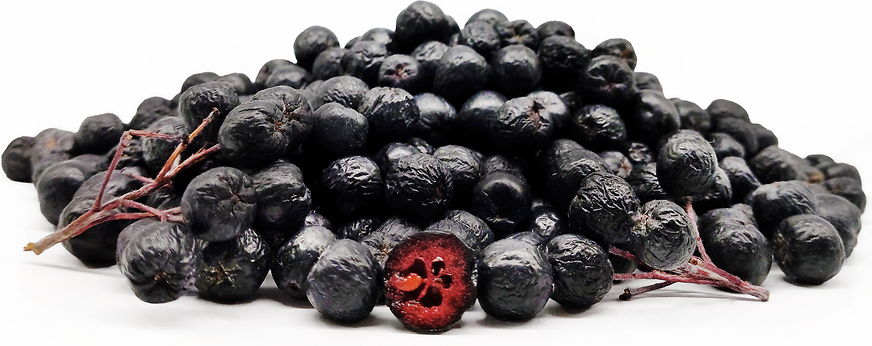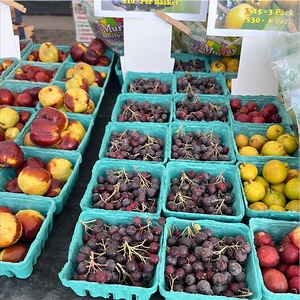


Michurin's Aronia Berries
Estimated Inventory, lb : 0
Description/Taste
Michurin’s Aronia berries are larger than other wild varieties, averaging 1 to 3 centimeters in diameter, and have a round to oval shape. The skin is shiny, semi-thin, and smooth, maturing to shades of purple-black, and are sometimes covered in a faint blue, waxy bloom. Underneath the surface, the flesh is soft and encases 1 to 5 seeds. The berries are considered ripe when their flesh displays dark red to purple hues, and it is important to note that only the flesh coloring is the determining factor. The degree of ripeness is not based on the skin’s coloring. Michurin’s Aronia berries will vary in flavor depending on the region it is grown in, but the berries generally contain a high tannin content, contributing to an astringent, sour, and subtly sweet taste.
Seasons/Availability
Michurin’s Aronia berries are available in the late summer through fall.
Current Facts
Michurin’s Aronia berries, botanically a part of the Aronia genus, are a hybrid variety belonging to the Rosaceae family. The dark purple-black berries are often associated with Aronia mitschurinii, a species crossbred in Russia from Aronia melanocarpa, Black Chokeberries, and Sorbus aucuparia, or Mountain Ash. Experts generally consider Michurin’s Aronia berries to be the cultivated version of wild Aronia berries, and there is some confusion between wild and cultivated species as many names are used interchangeably for both types of berries. In Russia, the berries are also known as Black Chokeberries, Rowan berries, Black-Fruited Aronia berries, and Aronia berries, and the cultivated species is found across Asia and Europe in home gardens, grown in containers, flower beds, and ground plots. The deciduous shrubs can reach up to three meters in height, and the berries grow in hanging bunches, eventually falling to the ground once ripe. Michurin’s Aronia berries are highly favored for their nutritional properties and are viewed as a health food, incorporated into a wide variety of processed applications to lessen the berry’s astringent flavor.
Nutritional Value
Michurin’s Aronia berries are an excellent source of anthocyanins, colored pigments found within the flesh that contain antioxidant-like properties to protect the body against free radical damage. The berries are also a rich source of vitamin A to maintain healthy organ functioning, vitamin C to strengthen the immune system, fiber to stimulate the digestive tract, and lower amounts of vitamins E and K. In addition to vitamins, Michurin’s Aronia berries also contain minerals such as potassium, calcium, magnesium, and iodine, depending on the region and soil the plant is grown in.
Applications
Michurin’s Aronia berries can be eaten straight, out-of-hand, but the fruits often contain a sour and astringent flavor that is considered unpleasant. The berries are primarily utilized in combination with sweeter elements and are popularly incorporated into fruit juices, smoothies, and tea. Michurin’s Aronia berries can also be cooked into a syrup and used as a topping over ice cream, simmered into compotes, jams, and jellies, baked into bars, scones, bread, or muffins, or processed into candies and gummies. In addition to fresh berries, Michurin’s Aronia berries can be dried for extended use and steeped into teas or sprinkled over cereals, yogurts, and salads. The berries can also be soaked in vodka and honey to make a tincture or a concentrated extract taken medicinally to help with sleep, digestion, or appetite, and are a famous wine produced in Russia. Michurin’s Aronia berries pair well with oranges, raspberries, apples, bananas, honey, cinnamon, and ginger. Fresh berries should be immediately consumed for the best quality and flavor and will only keep for a few days when stored in the refrigerator. Michurin’s Aronia berries can also be frozen for up to one year.
Ethnic/Cultural Info
In Russia, Michurin’s Aronia berries have become intertwined with a local tale of a lady named Aronia. Legend has it that Aronia was a beautiful woman who had the ability to heal people. Many suitors came to ask for her hand in marriage, but Aronia would challenge them with impossible tasks to avoid committing. One day, Aronia fell in love with a potential suitor, but he was eventually killed by his rivals out of jealously. Aronia attempted to use her gift of healing to save her love, but her powers were not enough to save him. Out of anguish, Aronia turned into a plant with dark red-black berries. These berries were discovered to contain high nutritional value and were eaten by local villagers to cure illnesses.
Geography/History
Aronia berries are native to Eastern North America, extending from Canada through the Southern United States, and have been growing wild since ancient times. There are many different species generally classified under the Aronia name, and for many years, Aronia berry species were primarily grown as ornamental landscape bushes in North America. It wasn’t until the early 20th century that Aronia melanocarpa, or Black Chokeberries, were introduced to Europe and were selected for commercial cultivation due to their high nutritional properties. One notable Russian breeder and botanist, Ivan Michurin, selected Aronia melanocarpa, Black Chokeberries and crossed them with Sorbus aucuparia, or Mountain Ash, to develop Aronia mitschurinii, a slightly sweeter, cultivated variety of wild Black Chokeberries. The new cultivar was first grown in the Altai Mountain Region at an experimental station, and over time, the variety was spread to research plots and home gardens throughout Russia. In the 1950s through the 1970s, the berries eventually made their way into gardens in Central and Northern Europe and East Asia. Today Aronia berries are found worldwide, grown in home gardens, and naturalized in wild areas such as forest edges and riverbanks. The berries are primarily found in processed or dried forms through online retailers, but fresh berries may be available seasonally through local farmer’s markets in North America, Europe, and Asia.
Recipe Ideas
Recipes that include Michurin's Aronia Berries. One
| Gastronom |
|
Aronia Sour - A Whiskey Sour Egg White Cocktail |
| Gastronom |
|
Aronia Berry Simple Syrup |
| Forager Chef |
|
SIMPLE CHOKEBERRY / ARONIA PRESERVES OR JAM |









